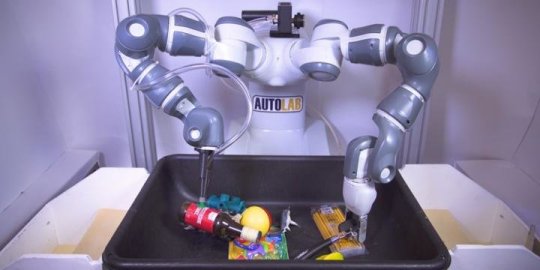[ad_1]
E-commerce continues to expand and achieved new levels during the recent holiday season. To rapidly fulfill the enormous volume and variety of orders, companies such as Amazon, Walmart, and Alibaba are investing heavily in new warehouses. To address the shortage of workers, many companies are considering robots. However, reliably grasping a diverse range of products remains a Grand Challenge for robotics.
In a paper published Wednesday, Jan. 16, in Science Robotics, engineers at the University of California, Berkeley present a novel, “ambidextrous” approach to grasping a diverse range of object shapes without training.
“Any single gripper cannot handle all objects,” said Jeff Mahler, a postdoctoral researcher at UC Berkeley and lead author of the paper. “For example, a suction cup cannot create a seal on porous objects such as clothing and parallel-jaw grippers may not be able to reach both sides of some tools and toys.”
Mahler works in the lab of Ken Goldberg, a UC Berkeley professor with joint appointments in the Department of Electrical Engineering and Computer Sciences and the Department of Industrial Engineering and Operations Research.
The robotic systems used in most e-commerce fulfillment centers rely on suction grippers which can limit the range of objects they can grasp. The UC Berkeley paper introduces an “ambidextrous” approach that is compatible with a variety of gripper types. The approach is based on a common “reward function” for each gripper type that quantifies the probability that each gripper will succeed. This allows the system to rapidly decide which gripper to use for each situation. To effectively compute a reward function for each gripper type, the paper describes a process for learning reward functions by training on large synthetic datasets rapidly generated using structured domain randomization and analytic models of sensors and the physics and geometry of each gripper.
When the researchers trained reward functions for a parallel-jaw gripper and a suction cup gripper on a two-armed robot, they found that their system cleared bins with up to 25 previously unseen objects at a rate of over 300 picks per hour with 95 percent reliability.
“When you are in a warehouse putting together packages for delivery, objects vary considerably,” said Goldberg. “We need a variety of grippers to handle a variety of objects.”
The research for this paper was performed at UC Berkeley’s Laboratory for Automation Science and Engineering (AUTOLAB) in affiliation with the Berkeley AI Research (BAIR) Lab, the Real-Time Intelligent Secure Execution (RISE) Lab, and the CITRIS “People and Robots” (CPAR) Initiative.
Story Source:
Materials provided by University of California – Berkeley. Note: Content may be edited for style and length.
[ad_2]















